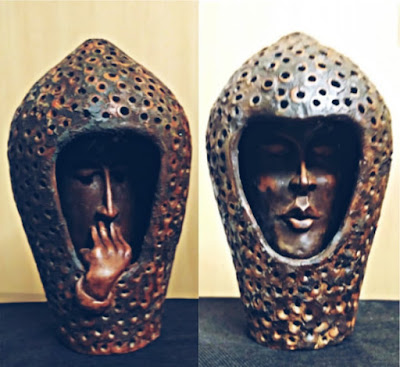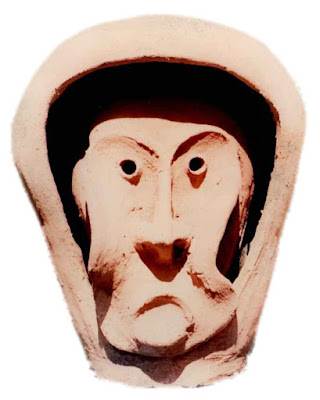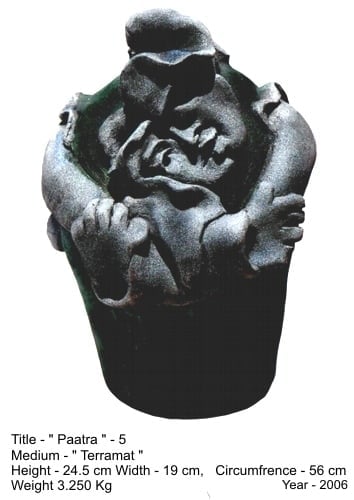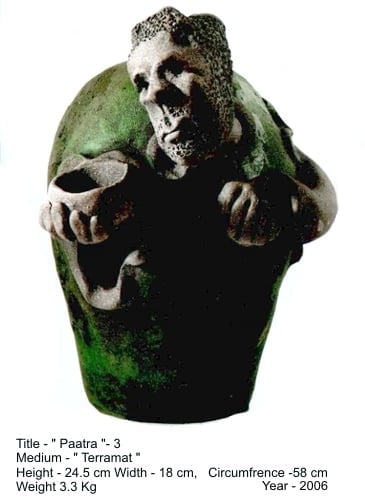De hace un par de años para acá, se interesa en el arte de la región centroamericana, el cual contribuye acertadamente a difundir estas experiencias en aquellas alejadas zonas del mundo.
Importa su participación en este nuevo proyecto de Museo de Pobre & Trabajador, la revista FATAL La Finalísima, blog Arbol Dardo, en tanto en la India, el arte tiene una profunda conexión con la espiritualidad. Ejemplo de este carácter -subraya Amit-, es la “Sanatana Sabhyata”, o civilización eterna de la India, conocida como la religión hindú.
Atendamos pues a sus razonamientos acerca de las creencias en su forma de cultura, la cual se distingue por su singularidad:
“Cuando tratamos de entender la espiritualidad hindú más profundamente -agrega Amit Ganjoo-, nos cercioramos que nuestras creencias tratan de conectar a los humanos con dicha espiritualidad. Agrega que es a través de la religión, que el ser humano puede alcanzar la conciencia absoluta, lo que finalmente conduce a la Salvación.”
A mis preguntas que intentan detallar y sacar a flote el significado de su creencia y forma de fe, Amit Ganjoo acota: “El hinduismo tiene una enorme casa del tesoro del conocimiento en forma de Shruti, Smriti y Vedas. Este conocimiento es asimilado y propuesto por los sabios teólogos de la India, aunque es muy difícil asimilar este conocimiento espiritual, en su forma real para la gente, es por esto que, para simplificar la comprensión de dicho conocimiento, se inventaron los “Puranas”, donde el conocimiento espiritual se transforma en forma de personajes simbólicos, e historias en forma textual”.
Me pregunto si en particular, dichas “Puranas” son afines a la Biblia cristiana, para lo cual, Amit, detalla:
“Estas se llaman historias mitológicas de las escrituras. La mitología dio origen a la “Iconografía” que describe las formas de los personajes y los iconos simbólicos relacionados con las Puranas”.
Amit, y, ¿como se conecta este conocimiento de lo sagrado, con el arte?
“Es a través de la iconografía: unión de la religión y el arte. Como todos sabemos, las imágenes atraen más a los ojos humanos que el texto, estas imágenes en forma de pinturas y esculturas, se están creando desde la antigüedad de nuestra cultura, siguiendo las descripciones de la iconografía”.
Además, agrega el artista: “El hinduismo no es una creencia rígida, ofrece libertad de elección en cada uno de sus aspectos. De manera similar, habla de las tres formas a través de las cuales uno puede alcanzar la espiritualidad suprema y finalmente la Salvación. Estos son:
Gyan Marg- Camino del Conocimiento.
Yog Marg- Una forma disciplinada de lograr la salvación mediante la combinación de Pranayam (técnicas de respiración, meditación y ejercicios físicos).
Bhakti Marg- Camino de devoción”.
Explica este artista de la India: “La primera forma es el “marg de Gyan”, lo que alcanzan las personas cuando logran un mayor nivel de conciencia, y son capaces de captar el conocimiento espiritual en su forma real, como los santos y los ascetas.
La segunda forma es el “yog Marg”, donde uno viaja a través del cuerpo burdo hasta el cuerpo sutil, y, finalmente, el individuo se convierte en uno con la espiritualidad, a través de las prácticas yóguicas.
La tercera vía es “Bhakti Marg”, o camino de la devoción, tiene un papel importante en el arte. La devoción consiste en emociones: amor, placer, belleza y estética, por eso lo artístico juega un papel integral en esta categoría”.
¿Que es el camino? ¿A que induce o a donde lleva?, y, ¿como se alcanza desde la práctica artística?
“El camino de la devoción requiere una imagen simbólica de Dios -aduce Ganjoo-, a la que un devoto puede expresar sus sentimientos y emociones. La imagen puede tener la forma de una imagen o un ídolo que tiene diferentes íconos significativos en forma de colores, gestos y posturas, diseños y expresiones devotas.
Rendirse a esta forma simbólica de Dios puede proporcionar conocimiento, así como la máxima alegría.
El Bhakti Marg también combina otras formas de arte, como la poesía en forma de himnos y diferentes oraciones que despiertan la conciencia humana, y, conducen a encontrar el camino de la espiritualidad.
De esta manera, el arte tiene un papel importante en la comprensión de la religión y la espiritualidad de la India.
En otro acercamiento al arte de Amit Ganjoo, que publique en la plataforma on line de la Wall Street International Magazine, edición española, Amit se refirió al hinduismo, como una filosofía espiritual de la vida de Vasudev kuthambakkam, quien predica que “todo el mundo es una familia. O sea que hablamos de amistad, aunque seamos desconocidos, y de alguna manera se razona en uno de los postulados de la política mundial: La paz, la concordia, la tolerancia sin distinción de credos, razón y posicionamientos ideológicos.
Sin embargo, y en tanto hablamos de amistad, también se enuncia la existencia de su opuesto, la enemistad: El enemigo siempre estará a la zaga, subvirtiendo con el aguijón de la discordia para desestabilizar la armonía de tal grado de conjunción.
Respecto al arte de Amit Ganjoo, refiero a un adentro y un afuera, pues el adentro sale a vislumbrar o percibir el afuera, y el afuera puede ojear lo interior. Sus objetos escultóricos, hechos de barro, entonces, son como una botella con un mensaje adentro, que se comunica a través de una ventana, abertura al universo que conecta con la espiritualidad.
Amit Ganjoo: Outside and Inside Amit Ganjoo, in principle, is a sculptor who works with clay and models figures with a discourse motivated by the spiritual, but he is also critical of reality. He creates emoticons in his creative work, which introduce a digital facet of his creative work, identifying signs and symbols of the world's cultures. Later, Amit is a cultural manager organizing exhibitions in the galleries of the educational compound where, in addition to teaching, he is the director, the School of Visual Arts, IPS Academy, Indore, India
From a couple of years ago, he has been interested in the art of the Central American region, which has successfully contributed to spread these experiences in those remote areas of the world.
Your participation in this new project by the Museum of the Poor & Worker, the FATAL magazine La Finalísima, blog Arbol Dardo, is important, while in India, art has a deep connection with spirituality. An example of this character, Amit emphasizes, is the "Sanatana Sabhyata", or the eternal civilization of India, known as the Hindu religion.
Let us therefore attend to their reasoning about beliefs in their form of culture, which is distinguished by its uniqueness:
"When we try to understand Hindu spirituality more deeply," adds Amit Ganjoo, "we make sure that our beliefs try to connect humans to that spirituality. He adds that it is through religion, that the human being can achieve absolute consciousness, which ultimately leads to Salvation. ”
To my questions that try to detail and bring out the meaning of his belief and form of faith, Amit Ganjoo notes: “Hinduism has a huge treasure house of knowledge in the form of Shruti, Smriti and Vedas. This knowledge is assimilated and proposed by the wise theologians of India, although it is very difficult to assimilate this spiritual knowledge, in its real form for people, that is why, to simplify the understanding of such knowledge, the "Puranas" were invented , where spiritual knowledge is transformed into symbolic characters, and stories in textual form ”.
I wonder if, in particular, these "Puranas" are related to the Christian Bible, for which, Amit details: "These are called mythological stories from the scriptures. Mythology gave rise to the "Iconography" that describes the forms of the characters and the symbolic icons related to the Puranas ".
Amit, and how is this knowledge of the sacred connected with art? “It is through iconography: union of religion and art. As we all know, images attract more human eyes than text, these images in the form of paintings and sculptures, have been created since ancient times in our culture, following the descriptions of the iconography ”.
Furthermore, the artist adds: “Hinduism is not a rigid religion, it offers freedom of choice in each of its aspects. Similarly, it speaks of the three ways through which one can attain supreme spirituality and ultimately Salvation. These are:
Gyan Marg- Path of Knowledge.Yog Marg- A disciplined way of achieving salvation by combining Pranayam (breathing techniques, meditation and physical exercises). Bhakti Marg- Path of devotion ”.
This artist from India explains: “The first form is the“ Gyan marg ”, what people achieve when they achieve a higher level of consciousness, and are able to capture spiritual knowledge in its real form, such as the Saints and the Ascetics.
The second form is the "yog Marg", where one travels through the gross body to the subtle body, and finally the individual becomes one with spirituality, through yogic practices.
The third way is "Bhakti Marg", or path of devotion, it has an important role in art. Devotion consists of emotions: love, pleasure, beauty and aesthetics, that is why the artistic plays an integral role in this category ”.
What is the way? What does it lead to or where does it lead, and how is it achieved from artistic practice? "The path of devotion requires a symbolic image of God," says Ganjoo, "to which a devotee can express his feelings and emotions. The image can be in the form of an image or an idol that has different significant icons in the form of colors, gestures and postures, designs and devout expressions.
Surrendering to this symbolic form of God can provide knowledge as well as maximum joy. The Bhakti Marg also combines other forms of art, such as poetry in the form of hymns and different prayers that awaken human consciousness, and lead to finding the path of spirituality.
In this way, art plays an important role in understanding the religion and spirituality of India. In another approach to the art of Amit Ganjoo, who published on the online platform of the Wall Street International Magazine, Spanish edition, Amit referred to Hinduism, as a spiritual philosophy of the life of Vasudev kuthambakkam, who preaches that “everyone it is a family. In other words, we speak of friendship, even though we are unknown, and somehow it is reasoned in one of the postulates of world politics: Peace, concord, tolerance without distinction of creeds, reason and ideological positions.
However, as we speak of friendship, the existence of its opposite, enmity, is also stated: The enemy will always lag behind, subverting with the sting of discord to destabilize the harmony of such a degree of conjunction. Regarding the art of Amit Ganjoo, I refer to an inside and an outside, because the inside comes out to glimpse or perceive the outside, and the outside can look at the inside. His sculptural objects, made of clay, then, are like a bottle with a message inside, which is communicated through a window, an opening to the universe that connects with spirituality. 1. The world observing Buddha 2. Meditating Buddha sculpture by-Amit Ganjoo












1 comentario:
Очень интересный художник!
Publicar un comentario